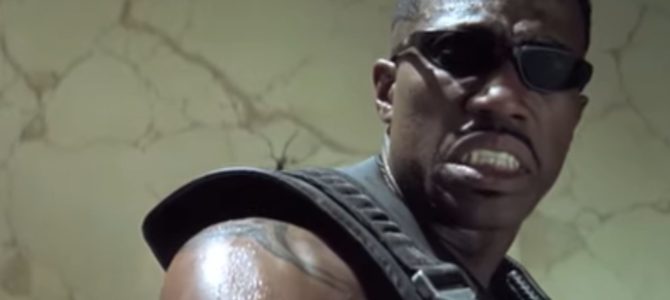
In cinema, particularly of the superhero variety, we live in an era of firsts. Captain Marvel beat out Wonder Woman to become the first woman to have the title role in a superhero movie. Captain America is hailed as the first Avenger. People tried to proclaim Black Panther as the first black protagonist in a superhero film, but they’re wrong. In the words of Yoda, there is another, and his name is Blade.
“Blade” cannot lay claim to the first movie in the Marvel Cinematic Universe, since it was made before Marvel Studios existed. It cannot pretend to be the first feature based on a Marvel character; that distinction goes to the “Captain America” released in 1944. It’s not even the second, which is 1986’s “Howard the Duck.”
But, regarding sword-wielding, crime-fighting, half-human, half-vampire, black comic book superheroes out for justice on the big screen, Blade was the first. And without his sword-wielding, crime-fighting ways — and the progression of the “Blade” trilogy itself — there would be no Marvel Cinematic Universe.
On Blade’s Origins
First, a little backstory. A vampire bit Blade’s mother while she was pregnant, and she died. Blade emerged from the ordeal neither human nor vampire but a hybrid. This imbued him with powers not enjoyed by normal vampires, particularly his ability to go out in sunlight. Like regular vampires, however, he must drink blood to stay alive. That’s where Whistler comes in.
Abraham Whistler was once a happily married father. Then, one night, a drifter came calling. That drifter turned out to be a vampire who killed his wife and daughters and left Whistler injured. In turn, Whistler dedicated his life to studying and killing vampires. Thus, when he met young Blade, born Eric Brooks, he was able to help him, first and foremost by developing a serum that allowed Blade to forgo sucking blood.
Now onto the trilogy. It started with the first and best film of the series, the eponymously titled “Blade.” In it, we meet the titular character, played by Wesley Snipes, and Whistler, played by Kris Kristofferson. Blade’s goal is simple: He wants to kill all vampires. Vampire Deacon Frost, coolly played by Stephen Dorff, not only doesn’t want to be killed, but also needs Blade to fulfill a prophecy and unleash the blood god, meaning Frost can’t just avoid Blade.
Instead, Frost must confront him. Along with sidekick Donal Logue — who never went on to become Jon Favreau despite seemingly having the same indie/big budget pedigree — and his other minions, he and Blade fight, repeatedly, with Frost almost killing Blade en route to summoning the blood god. Alas, for Frost, Blade’s mastery of martial arts, timing, and cunning were vastly superior, and Blade lived to kill more vampires over the course of two more movies.
Comic Book Movies Were Once a Risk
After movies featuring a preponderance of roundhouse kicks were all the rage, and before movies based on comic characters were, comic book movies were risky business. Despite this, Snipes, Kristofferson, and Dorff signed on to a kung fu vampire movie. To be fair, Dorff actually thought it would ruin his career. Instead, it ended up being one of the things that helped launch it. Snipes and Kristofferson apparently just recognized a great script when they saw it.
Sure, the computer-generated imaging is terrible. Technology was a little different in 1998, and audiences weren’t lining up to watch series that take 23 films and feature huge ensemble casts, so they couldn’t just throw money away. But the acting in “Blade” is superb, the roundhouse kicks and swordsmanship perfect, and the story compelling, despite overtly being the first in a series of films at a time when viewers hadn’t yet gone all-in on franchises.
It was no slouch at the box office, either, with the trilogy earning a total of more than $415 million on combined budgets of $164 million. No, that’s not “Endgame”-level money, not even close, but who among us would turn down more than $252 million in profits on an investment of $164 million?
The soundtracks are also excellent, replete with a mixture of hip-hop, trip-hop, and other forms of electronica. They don’t exactly presage the soundtracks to the “Guardians of the Galaxy” movies, but they do embrace solid song selection and the importance of music in helping to drive the action. With the “Blade” trilogy, the music isn’t just background noise, it’s part of the story.
The Thing About Ryan Reynolds
“Blade II” and “Blade: Trinity” also offer star power, plenty of raging battles, dated CGI, and solid soundtracks. The second installment is cheesier with the whole Reaper angle — Reapers being cursed bastards created by the vampires in an attempt to make their own “daywalkers,” the term used for Blade — but it’s still miles and miles ahead of all the “Hulk” movies, and people pretend to like those. There’s also a parallel to Thanos and Nebula’s relationship in the father-daughter dynamic between Damaskinos and Nyssa.
“Blade: Trinity,” in which Ryan Reynolds stars before finding his home as Deadpool, is better than “Blade II,” but it isn’t as emotionally satisfying as the original film. It does, though, foreshadow themes that come up in later Marvel movies. The opening narration Reynolds offers, for example, is remarkably similar, stylistically, to Deadpool’s narration at the start of “Deadpool 2.” And Reynolds doesn’t kill his “Blade: Trinity” character as he does many of his other characters, such as in the close to “Deadpool 2,” so there’s that.
As to the entire “Blade” trilogy, factor in Ron Perlman, Norman Reedus, Patton Oswalt, Parker Posey, and Jessica Biel in the second and third installments, plus the story arc that covers Whistler’s entire life and legacy, and we’ve got true foreshadowing for what Marvel can do and who it can land. Again, this was before comic book superhero movies were the cat’s meow. These were groundbreaking flicks in which people with varying pedigrees said, “Karate-battling vampires? Yes, I’m in.” “Blade” may not have been the first in the Marvel Cinematic Universe, but without it, there would be no Thanos. And unlike Thanos, Blade is back.
Marvel recently announced Blade is returning, this time as part of the universe, although Blade seems only recently to have crossed paths with the Avengers. For those of us with the requisite tastes to have not only eagerly watched the original “Blade” trilogy, but purchased the DVDs, it’s about time. Not because the original trilogy wasn’t exquisite — oh, it was — but because the characters and the storylines are interesting, entertaining, and they work on the screen.
No Matter If We Don’t Know What We’re Talking About
Comic books were once the purview of nerds. Well, that is still the case, and those nerds look down upon those of us whose knowledge is mostly relegated to what we’ve learned from the big screen. Nevertheless, the fact that we do know those limited storylines means the genre crossed over into the big time. And it all started with that half-human, half-vampire hero out for justice and a story that spanned three films.
Will the new “Blade” be as awesome as the original cinematic incarnation? Let’s be optimistic. The Marvel Cinematic Universe is just plain fun and shows no signs of slowing, but it wouldn’t exist without the first black superhero to grace the big screen. It’s about time Blade joins the rest of the Avengers in that universe. It’s a universe that doesn’t have an end, although sometimes its heroes do.
We’ve lost Captain America and Iron Man, who couldn’t heal himself one last time. We haven’t lost Blade. As a vampire, Blade heals himself, too, but he can’t permanently heal himself any more than Tony Stark could. Others could heal him, unlike Stark, but he isn’t done. As he says after being offered a cure for his vampirism, “You keep your cure. There’s still a war going on, and I have a job to do.”









